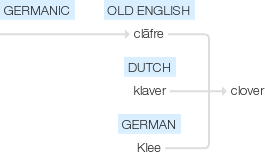Clover
Old English clāfre, of Germanic origin; related to Dutch klaver and German Klee .
wiktionary
From Middle English clovere, claver, from Old English clāfre, earlier clǣfre, from Proto-West Germanic *klaibrā. Cognate with Saterland Frisian Kleeuwer(“clover”), West Frisian klaver(“clover”), Dutch klaver(“clover”), German Low German Klaver(“clover”), German Klee(“clover”).
etymonline
clover (n.)
plant of the genus Trifolium, widely cultivated as fodder, Middle English claver, from Old English clafre, clæfre "clover," from Proto-Germanic *klaibron (source also of Old Saxon kle, Middle Low German klever, Middle Dutch claver, Dutch klaver, Old High German kleo, German Klee "clover"), which is of uncertain origin. Klein and Liberman write that it is probably from West Germanic *klaiwaz- "sticky pap" (see clay), and Liberman adds, "The sticky juice of clover was the base of the most popular sort of honey."
The modern spelling prevailed after c. 1700. The exact phrase four-leafed clover attested from 1831; first reference in English to the supposed luck of a four-leaf clover is from c. 1500 ("The Gospelles of Dystaues"). The ratio of four- to three-leaved clovers is said to be 1 in 10,000 or 1 in 5,000. To be in clover "live luxuriously" is 1710, "clover being extremely delicious and fattening to cattle" [Johnson].
